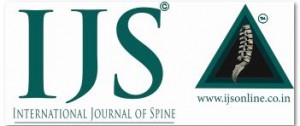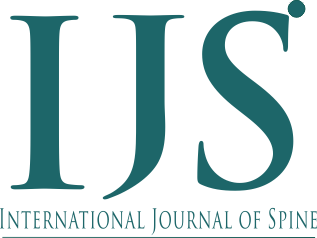Shoulder Balance and Scoliosis
Volume 1 | Issue 1 | Apr – June 2016 | Page 31-32|Ketan Khurjekar[1].
Authors :Ketan Khurjekar[1]
Sancheti Institute for Orthopaedics &Rehabilitation, Pune, India
Address of Correspondence
Dr Ketan Khurjekar
Sancheti Institute for Orthopaedics &Rehabilitation, Pune, India
Email: kkhurjekar@googlemail.com
Abstract
Abstract: Shoulder imbalance is a fairly new outcome variable that is been associated with complex spinal deformities. The presentation of should imbalance is variable and depends on the extent, severity of primary curve, compensatory curves and overall balance of the spine both in sagittal and coronal planes (rotatory planes). It is definitely an important outcome measure in terms of satisfactory patient outcome, however factors that affect it are still unclear and more studies are required. Current article focusses on the basics of shoulder imbalance and currently available methods of measuring it.
Key Words: Adult spinal deformity, shoulder imbalance, cosmoses.
Introduction
Shoulder Balance and Scoliosis
Scoliosis though termed as a coronal deviation in normal architecture of spine, it is often found that there is sagittal imbalance associated with the rotation of the spinal column. Scoliosis is a 3-D deformity and its rotation element was not taken into consideration till recent times. Sagittal imbalance or coronal deviation along with rotational mal-alignment gives obnoxious spinal deformity and severity is perceived more because of shoulder imbalance. Shoulder imbalance is reported as difference in shoulder asymmetry. Residual shoulder asymmetry ruins the result of good anatomical Cobb to Cobb correction. Patient undergoing spinal fusion surgery did not do well unless the sagittal Balance is corrected. It plays important role in cosmesis achieved after surgery. It is unclear, that which factors of scoliosis complex determines the shoulder balance. How does preoperative severity of shoulder imbalance affect the post operative outcome still remains speculative. Why only proximal thoracic and main thoracic curve are given significance when we talk about shoulder balance is topic of discussion? Just as a corollary, for years abnormal abdominal reflex was considered to be indicator of intraspinal problem. Yngve demonstrated that abnormality of abdominal refelex was seen in 27 % of normal individuals[1]. Shoulder imbalance associated with proximal curve, dictates the long fusion surgery till T2 which balances out the shoulder and helps achieve good cosmetic correction. If left shoulder is higher > 5 mm in right proximal thoracic curve, then including proximal thoracic curve in instrumentation is mandatory. As per Lenke et al, if left shoulder is higher in a right proximal thoracic curve, upper instrumented vertebra (UIV) would be T2. If right shoulder is higher, then UIV would be T4. If both shoulders are equal, then fusion would be restricted to T3 [2]. Pelvic girdle is base of spine foundation. Any deviation or malalignment of spine is noted as abnormal pelvic tilt. But pectoral girdle has no direct attachment. So it has been postulated that correction of chest wall deformities can correct shoulder level and Scapulae to give desired shoulder balance [3].
Few of the Current practices of measuring shoulder Imbalance [4]
· Curve pattern on standing AP and Lateral (whole Spine Scannograms) are mandatory to measure shoulder asymmetry
· T1 tilt- Positive T1 tilt is defined as the angulation of upper end plate of T1 to the horizontal with the proximal vertebral body up and right lower vertebral body down
· Clavicle Angle- Intersection of horizontal line and tangential line connecting the higher two points of each clavicle. Positive clavicle angle means left clavicle is up and right clavicle is down
· T1-ICL correlation- T1 vertebral tilt and intercoracoid line (ICL) tilt have simplified measurement of shoulder balance. T1-ICL relationship is concordant or discordant. Relationship is concordant if T1 is tilted to the same side as that of ICL. Similarly it is discordant if T1 has tilted in opposite direction of ICL [3].
· Coracoid Height Difference- Difference between two horizontal lines drawn from each coracoid will tell us about Coracoid Height difference.
· Trapezius length- Showed weak correlation with post-operative shoulder balance
· First rib- Clavicle height- Vertical distance of first rib apex to superior clavicle
· RSH- radiographic Shoulder height- Graded height difference of Soft tissue shadow directly superior to acromio-clavicular joint in AP view. When imbalance is more than 3 cm, it is called as Significant Shoulder Imbalance. Moderate imbalance would be 2 to 3 cm and less than 1 cm would be minimal shoulder imbalance.
In a series of 112 cases, Kuklo et al4 concluded that the clavicle angle and not the T1 tilt is the best predictor of preoperative and post operative shoulder balance. Standing Proximal Cobb and side bending Cobb is considered as essential part of survey.
Determination of UIV would have bearing on post-op shoulder balance. Whether to stop at T2 or T3 or T4 is unclear. Suk et al has suggested that neutral vertebra of the proximal thoracic curve should be selected as UIV irrespective of shoulder level particularly when all pedicle screw construct is used [5]. However above findings are true if the curve T1-ICL concordant. Means if the T1 is tilted along with the proximal curve then depressing the neutral vertebra or T1 will get the shoulder balanced. As against that, if the proximal thoracic curve is T1-ICl discordant, then depressing T1 will further enhance the shoulder imbalance [3]. Only radiological shoulder balance doesn’t correlate with the clinical appearance. Correcting T1 tilt radiologically will correct Shoulder balance has proven to be myth beyond doubt. Researchers from Turkey evaluated shoulder balance radiologically and clinically in healthy adults and proved that shoulder balance in healthy adults doesn’t exist [6].
Healthy adolescent patients almost 19 % had asymmetric shoulders and almost 72 % had side to side difference of < 1 cm. None of the individuals ever complained of shoulder imbalance. The radiological shoulder balance parameters reliably reflect the clinical appearance. Coracoid height difference is taken into consideration when shoulders are included in radiographs and clavicular tilt angle is considered when shoulders are obviated. Researchers from Japan have classified shoulder balance broadly into medial and lateral shoulder height asymmetry. Medial differences reflected in trapezial prominence created by upward tilted proximal ribs and tilted T1. Lateral shoulder height asymmetry correlates weakly with clavicular angle. Correlation of trapezial prominence is more predictable to compare after scoliosis surgery [7]. Shoulder balance is considered as paramount indicator in cosmesis correction. It has significant impact of patient’s self-perception [8]. Generally anterior shoulder balance is perceived by patient and posterior shoulder balance is perceived by clinician. From patient’s perspective, achieving anterior shoulder balance is vital. Both, anterior and posterior shoulder balance were thought to be correlating equally. Unlike, it is showing weak correlation and it is recommended for clinicians and surgeons to evaluate both sided in planning deformity correction, particularly Lenke type 2 curves [8]. Chinese workers have affirmed that radiologic parameters alone will not guide post-operative shoulder balance. We should pay more attention to clinical cosmetic correction than only radiological angle restoration to get proper shoulder balance. We should not only include shoulder height but should also include the shoulder angle, axilla angle and areal balance between left and right shoulder. Qiu et al has suggested that estimate of shoulder height, which is intersection of clavicle and rib cage is the most reliable landmark. It will guide in assessing shoulder balance to better extent [9]. To Summarise, the shoulder balance is an area of complexity with many researchers with their experienced thought process. The common mandate is to get satisfactory cosmetic correction of scoliosis for patient as well as clinician.
References
1. Yngve D. Abdominal reflexes J Pediatric orthop. 1997: 17(1): 105-108
2. Lenke LG, Bridwell KH, O’Brien MF, et al. Recognition and treatment of proximal thoracic curve in adolescent idiopathic scoliosis treated with Cotrel-Dubousset instrumentation. Spine. 1994;19:1589-1597
3. Menon KV, Tahasildar N, Pillay HM, Ambuselvum M, Jayachandren RK. Patterns of Shoulder Balance in Idipopathic Scoliosis. J Spinal Disord Tech 2014;27:401-408
4. Kuklo TR, Lenke LG, Graham EJ, Won DS, Sweet FA, Blanke KM, Bridwell KH. Correlation of radiographic, clinical, and patient assessment of shoulder balance following fusion versus nonfusion of the proximal thoracic curve in adolescent idiopathic scoliosis. Spine (Phila Pa 1976). 2002 Sep 15;27(18):2013-20.
5. Suk SI, Kim WJ, Lee CS, Lee SM, Kim JH, Chung ER, Lee JH. Indications of proximal thoracic curve fusion in thoracic adolescent idiopathic scoliosis: recognition and treatment of double thoracic curve pattern in adolescent idiopathic scoliosis treated with segmental instrumentation. Spine (Phila Pa 1976). 2000 Sep 15;25(18):2342-9..
6. Akel I, Pekmezci M, Hayran M, Genc Y, Kocak O, Derman O, Erdogan I, Yazici M. Evaluation of shoulder balance in the normal adolescent population and its correlation with radiological parameters. Eur Spine J. 2008;17: 348-354.
7. Ono T, Bastrom TP, Newton PO. Defining 2 components of shoulder imbalance. Spine 2012; 37: E1511-E1516
8. Yang s, Feuchtbaum, Werner BC, Cho W, Reddi V, Arlet V. Does anterior shoulder balance in adolescent idiopathic scoliosis correlate with posterior shoulder balance clinically and radiologically. Eur Spine J. 2012: 21: 1978-1983
9. Qiu XS, Ma WW, Li WG, Wang B, Yu Y, Zhu ZZ, Qian BP, Zhu F, Sun X, Ng BK, Cheng JC, Qiu Y. Discrepancy between radiographic shoulder balance and cosmetic shoulder balance in adolescent idiopathic scoliosis patients with double thoracic curve. Eur Spine J. 2009 Jan;18(1):45-51.
| How to Cite this Article: Khurjekar K. Shoulder Balance and Scoliosis. International Journal of Spine Apr – June 2016;2(1):31-32 . |



